Merwilla dracomontana
Merwilla dracomontana (Hilliard & B.L.Burtt) Speta (= Scilla dracomontana Hilliard & B.L.Burt)
Family: Hyacinthaceae
Common names: miniature blue squill, moutain squill, dragon mountain squill, alpine squill
Introduction
The miniature blue squill is a bristly, dwarf bulbous plant from the hyacinth family in the genus Merwilla, native to the Drakensberg foothills of KwaZulu-Natal and the Eastern Cape. The species is closely related to two other species in KwaZulu-Natal, Merwilla plumbea subsp. kraussii and Merwilla plumbea.
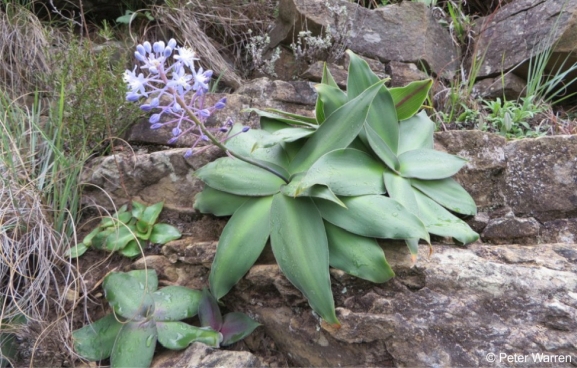
Description
Description
Merwilla dracomontana, previously known as Scilla dracomontana, is a deciduous, summer-growing bulb, that goes dormant in winter. This species is distinguished from two other related species by having leaves that are flat on the ground and mature during the flowering season, while the other two species have leaves that are erect and are not mature during flowering time. Flowering occurs in spring (September to November) with blue, pale blue or violet, star-shaped flowers, which consist of 6 petals. The flowers are unscented and are borne on peduncles.
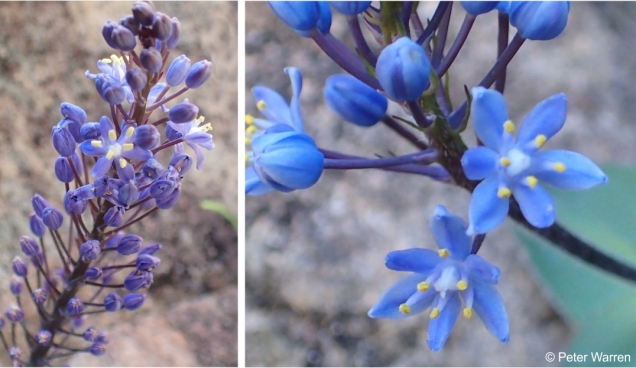
The leaves are linear, smooth, glossy, and dark green and can reach a length of 100-200 mm. Merwilla dracomontana grows up to 150 mm in height and produces shorter inflorescences and smaller bulbs than the common Merwilla plumbea. The bulbs are globose, growing below or above the ground, and are about 50 mm in length and 30 mm in diameter, with scales that are papery-cartilaginous and chestnut-brown in colour, forming from the exterior. The roots are thick and tough.

Conservation Status
Status
Merwilla dracomontana is currently assessed as Least Concern (LC) in the Red List of South African Plants, meaning that the population is stable in the wild and there are no threats currently affecting the population.
Distribution and habitat
Distribution description
Merwilla dracomontana is endemic to South Africa, where it occurs naturally in KwaZulu-Natal in the Drakensberg Mountains between 1 625m and 2 100 m altitude in the surrounding foothills from Giant’s Castle in the Estcourt district to the upper Umzimouti Valley in the Underberg district, extending to the KwaZulu-Natal midlands in the Lion’s River district and Karkloof. It has recently also been identified at Mt. Currie near Kokstad in the Eastern Cape.
This bulb grows in terrestrial ecosystems, on sandstone cliffs, in hard-packed earth, in the ground and in rock crevices, often forming large colonies. This species hybridizes easily with M. plumbea.
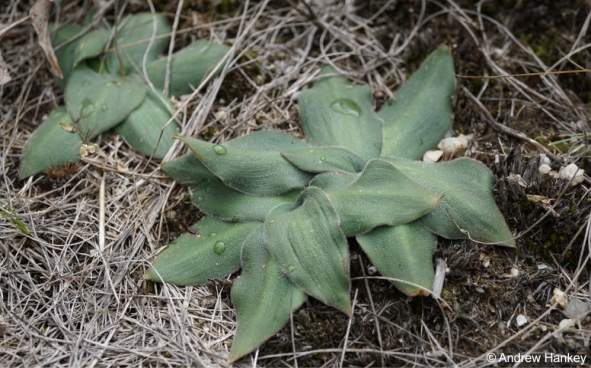
Derivation of name and historical aspects
History
This genus is named after Frederick van der Merwe (1894-1968), a botanist who worked on this family. The species name refers to the area where the species occurs, the Latin word draco means ‘dragon’ and montana means ‘mountain’, hence ‘dragon mountain’, the English translation of Drakensberg, the mountain range that is home to this species.
Merwilla dracomontana was previously called Scilla dracomontana and it falls under the Hyacinthaceae family. This is a family of perennial bulbs and it consists of ±46 genera and ±900 species found in Africa, Eurasia and North America but most richly represented in southern Africa and in the Mediterranean region to south west Asia. Other popular South African genera within this family are Eucomis, Ornithogalum, Lachenalia, Hyacinth and Veltheimia.
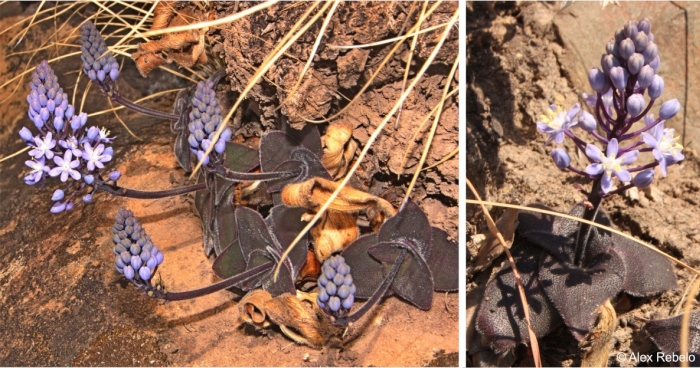
Uses
Use
The miniature blue squill is used in gardening as container and rock garden subjects, but it is not as popular as the tall blue squill, Merwilla plumbea in the horticulture industry.
Merwilla bulbs are known to be poisonous to humans and livestock. There is no evidence of Merwilla dracomontana being used medicinally. The closely related Merwilla plumbea is used medicinally despite being poisonous, it is one of the most commonly traded medicinal plants in KwaZulu-Natal.
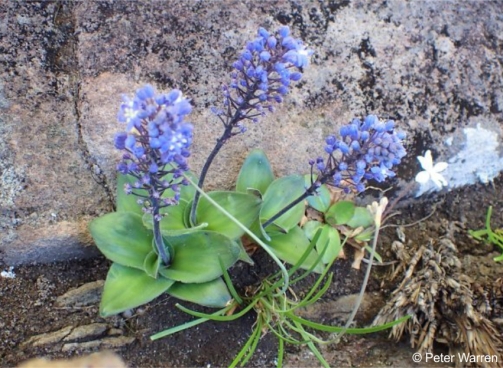
Growing Merwilla dracomontana
Grow
The miniature blue squill is relatively tolerant of drought. This is a deciduous bulb and since it naturally occurs in the summer rainfall region, it should be watered in spring and summer but watering must be reduced as soon as the leaves die back. It is best to keep them dry during winter. Merwilla dracomontana is regarded as frost hardy since it can survive the cold Drakensberg winter temperatures that sometimes drop as low as -7°C. When grown in containers, it is best to put them indoors or inside greenhouses during the cold winter months.
They can be grown from seeds or by division of offsets. Sow seeds in spring, in trays or pots that are not less than 10 cm deep, in a well-drained medium. Once germinated, the bulblets should be left undisturbed and will flower in the third or fourth season.
It creates bulblets at the base of mother bulb and they can be removed and replanted during winter, when they are dormant. When planting, the top of the bulb should be at or just below the ground level, in containers or on a sunny veranda. This genus is not susceptible to significant pest and diseases.
References
- Bangani, V. 1998. Homoisoflavonoids and stilbenoids from Scilla species. Master of Science Thesis, Department of Pure and Applied Chemistry, University of Natal, Durban.
- Hankey, A. 2019-01-25. Observation of Merwilla dracomontana, Mkhomazi Wilderness area, KwaZulu-Natal.iNaturalist. Online. https://www.inaturalist.org/observations/19965083.
- Hilliard, O.M. & Burtt, B.L. 1972. Notes from the Royal Botanic Garden, Edinburgh 31(3): 335-337.
- Hilliard, O.M. & Burtt, B.L. 1982. Notes from the Royal Botanic Garden, Edinburgh 40(2): 283-284.
- Klopper, R.R & Victor, J.E. 2005. Merwilla dracomontana (Hilliard & B.L.Burtt) Speta. National Assessment: Red List of South African Plants version 2020.1. Accessed on 2023/06/15.
- Manning J.C. 2019. Systematics of the sub-Saharan African squills: The genera Merwilla, Pseudoprospero, Schizocarphus and Spetaea (Hyacinthaceae: Scilloideae). South African Journal of Botany 125: 411–426.
- Manning, J.C., Goldblatt, P. & Fay, M.F. 2004. A revised generic synopsis of Hyacinthaceae in sub-Saharan Africa, based on molecular evidence, including new combinations and the new tribe Pseudoprospereae. Edinburgh Journal of Botany 60: 533–568.
- McCartan, S.A & Van Staden, J. 2002. Micropropagation of Scilla kraussii and Scilla dracomontana. South African Journal of Botany 68: 223–225.
- Rebelo, A. 2020-09-12. Observation of Merwilla dracomontana, Highmoor, KwaZulu-Natal. iNaturalist. Online. https://www.inaturalist.org/observations/59654168.
- Speta, F. 1998. Systematische analyse der gattung Scilla L. s.l. (Hyacinthaceae). Phyton 38: 1-224.
- Van Staden, J. & Pan, M. 2001. Genetic diversity of blue-flowered Scilla species as determined by random amplified polymorphic DNA. South African Journal of Botany 67: 344-348.
- Warren, P. 2017-10-15. Observation of Merwilla dracomontana, Mkhomazi Wilderness area, KwaZulu-Natal.iNaturalist. Online. https://www.inaturalist.org/observations/8517999.
- WFO The World Flora Online, Merwilla dracomontana (Hillard & B.L.Burtt) Speta. http://www.worldfloraonline.org/taxon/wfo-0000690158#B. Accessed 20 Jun 2023.
Credits
Dineo Dibakwane and Sharlotte Kwenaite
Walter Sisulu National Botanical Garden
August 2023
Acknowledgements: the authors thank Peter Warren, Andrew Hankey and Alex Rebelo for making their pictures available on iNaturalist.
Plant Attributes:
Plant Type: Bulb
SA Distribution: Eastern Cape, KwaZulu-Natal
Soil type: Sandy, Loam
Flowering season: Spring
PH: Acid, Neutral
Flower colour: Blue
Aspect: Full Sun
Gardening skill: Average
Special Features:
Horticultural zones









Rate this article
Article well written and informative
Rate this plant
Is this an interesting plant?
Login to add your Comment
Back to topNot registered yet? Click here to register.